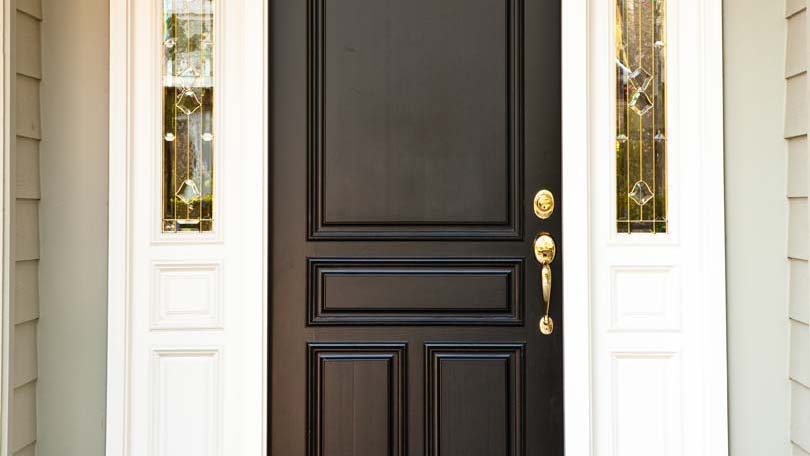
Whether you have a new exterior door to paint or are going to repaint an existing door, the techniques are basically the same. Repainting an old door requires some additional steps such as removing hardware, sanding and priming. This article will describe how to paint an exterior door, both new and old, in 10 steps.
What You Will Need
Painting a new exterior door will require:
- Clean rags
- Drop cloth
- Mini roller
- Paintbrush
- Bucket
- Roller tray or grid
- Paint
- Sawhorses
- Masking tape
Additional items needed for painting and repainting may include:
- Sandpaper
- Screwdriver
- Sander
- Tack cloth
- Caulk
- Putty knife
Step One: To Prime or Not Prime?
If you bought a new door, it may already be primed. The door, which will usually be some shade of grey, has been primed in the factory according to specifications that will allow it to readily accept paint. Do not prime it again. Metal doors are always primed.
If you buy a new wood door, it may not be primed. If this is the case, first ensure that the door is totally free of dust and dirt. Then place the door on the sawhorses.
Step Two: Remove All Hardware
If you’re preparing to paint an old door or a new one with hardware, it’s best to remove all of the items, including hinges, doorknob, doorknocker, strike plate and peephole. You may also use masking tape to protect them from the paint but this is not recommended due to the fact that this makes it harder to ensure the areas around the hardware are properly covered.
Step Three: Sanding the Door
If you have an old wood door, you’ll need to sand and scrape off all old paint and any dirt on the door. A palm sander holding 80-grit sandpaper works well and will help make this job go quickly. Once the surface is smooth you’re ready to move on.
If you have an old metal exterior door, you’ll need to sand any rust down. For this job use a palm sander with 50-grit sandpaper. The surface needs to feel smooth and be free of rust.
Step Four: Making Sure the Exterior Door is Clean
Before priming your door be sure to wipe off any excess dust or rust and rub down the surface with a tack cloth. Any foreign material will inhibit the paint from adhering to the door’s surface.
Step Five: Priming the Exterior Door
Using either water based acrylic paint for wood or an oil primer for metal, paint the door’s six sides—the exterior, interior and each of the four edges. Priming all sides will help ensure the durability of the door.
Step Six: Fixing Cracks
Inspect an older wood door for any cracks. Fill the cracks with caulk, using a putty knife to ensure the crack is filled properly and the surface flush with the door. Once the caulk is dry, prime that section again.
Step Seven: Painting Techniques
If you have a door that offers a totally smooth surface, that is one without panels, then you can use a small roller to paint the door. If your door has panels, then paint the recessed parts first with a brush, starting with the corners. Then paint the raised surfaces with a small roller. Whether the door is flat or paneled, use a brush to paint the areas near the edges. Don’t overload the brush or roller with paint and don’t allow it to puddle on the door.
Step Eight: Painting the Door
Paint the exterior side first. If your door opens in, you’ll need to paint the hinged side of the door the same color. If painting a wood door, always go with the grain. Paint stiles, the long sides of the door, with the grain, which will be up and down, and the rails, the top and bottom edges, side to side.
Step Nine: Drying
Allow the door 24 hours to dry. Be sure to seal up your paint and clean brushes, rollers and pans. Also, secure all hardware.
Step Ten: Additional Coats
Chances are your door will need at least one additional coat if not more. The darker the color, the more coats you will need. After the door is dry, wipe down with a clean cloth and with a tack cloth to remove any dirt or dust that may have accumulated. Paint the door again as described above, allowing it to dry before applying a third coat.
It’s best to paint the interior part of the door after the exterior, stiles and rails are done. You can prime the interior and perform any prep work needed at the same time that you are working on the exterior. When painting the interior approach it in same manner in which you did the exterior.
Express Yourself with Taste
Painting an exterior door is a great way to add a tasteful accent to your home and to bring its look and style together. If you do the job right, your door will look better and last longer.
